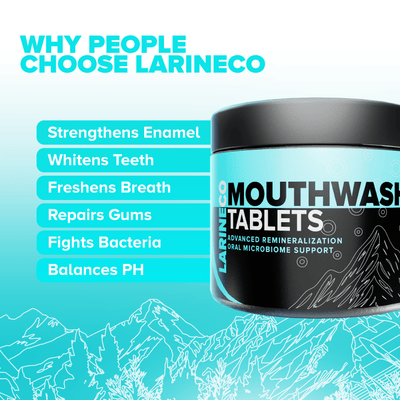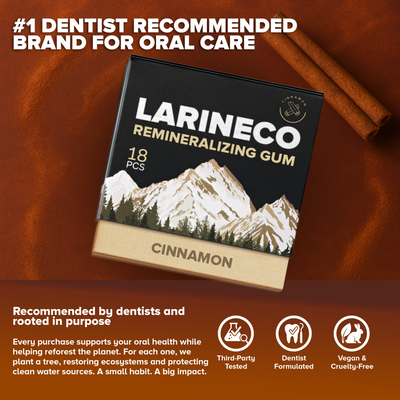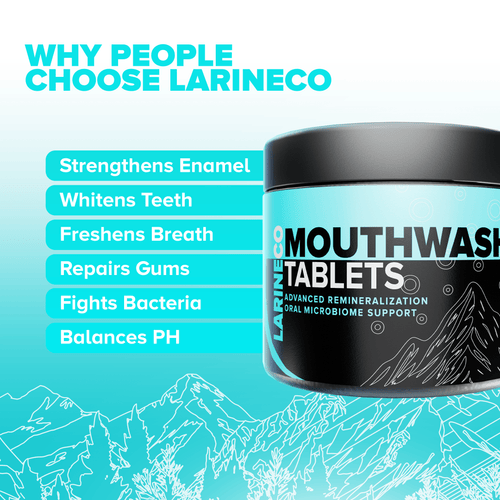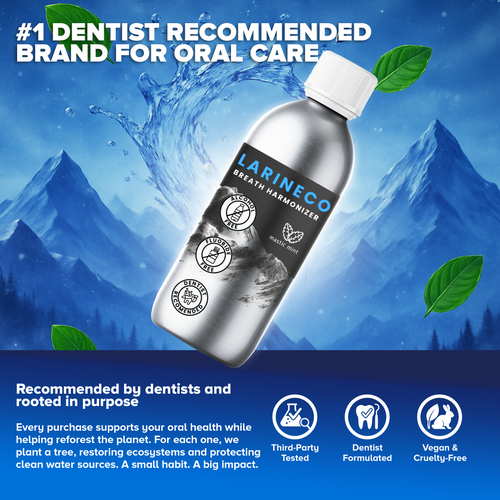How Nano-hydroxyapatite Repairs Dentin Exposed by Receding Gums
Introduction: The Silent Damage Caused by Receding Gums
Gum recession doesn’t scream for attention, at least, not at first. It starts subtly: your teeth look a little longer, your gums a little thinner. No bleeding, no pain, just a slow retreat that most people overlook. But beneath this quiet shift lies an escalating problem. As the gum line pulls back, it exposes the softer, more vulnerable layer beneath the enamel: dentin. And once dentin is exposed, the real trouble begins.
What Happens When Gums Recede
Your gums are not just a cosmetic feature; they’re a biological seal that protects the roots of your teeth. When they recede, that seal is broken. The roots, unlike the crown of the tooth, are not covered with tough enamel. Instead, they're shielded by cementum, a far thinner and more delicate layer. Once exposed, even mild physical or chemical stimuli brushing, cold drinks, and acidic foods, can irritate the underlying dentin and lead to discomfort or even sharp pain.
But this exposure isn’t just a matter of sensitivity. Receding gums create gaps or “pockets” between the teeth and the gum line. These pockets trap bacteria and plaque, accelerating the cycle of inflammation, further gum loss, and potentially even bone erosion. Left unchecked, recession can lead to tooth instability and ultimately, tooth loss.
How Dentin Exposure Triggers Tooth Sensitivity
To understand why exposed dentin hurts, you need to understand what dentin is. Dentin is the porous layer of tissue beneath your enamel, composed of tiny microscopic tubules, thousands of them per square millimeter, that lead directly to the nerve inside your tooth.
When dentin is protected by enamel or healthy gums, you feel nothing. But when it’s exposed, those open tubules act like conduits. Cold air, heat, sugary foods, or even a simple sip of water can travel straight to the nerve, triggering a sharp, electric-like pain. This is why sensitivity from gum recession feels sudden and intense, because it is.
Why Traditional Toothpaste Often Falls Short
Most over-the-counter toothpastes are designed for plaque removal, whitening, and general cavity prevention. But they’re not formulated to deal with the structural issues caused by gum recession. Whitening toothpastes, for instance, can actually worsen sensitivity by being overly abrasive, wearing down already-thin enamel, and irritating exposed dentin even further.
Even so-called “sensitive toothpastes” often provide only surface-level relief. Many simply numb the nerve or temporarily block the tubules, a band-aid solution that doesn’t address the root cause: gum tissue loss and dentin exposure.
Worse, they do little to remineralize weakened areas or protect against further damage. Without targeted intervention, the cycle of erosion, sensitivity, and gum recession continues unchecked.
What Is Nano-Hydroxyapatite (Nano-HA) And Why Does It Matter?
Nano-hydroxyapatite (nano-HA) is a synthetic form of the natural mineral hydroxyapatite, which makes up nearly 97% of tooth enamel and 70% of dentin. The "nano" part refers to its ultra-small particle size, typically less than 100 nanometers, allowing it to interact with your teeth on a microscopic level. Unlike fluoride, which strengthens enamel from the outside, nano-HA rebuilds it from within by filling in microscopic cracks and lesions with a biomimetic structure that closely resembles natural tooth mineral. This makes it a powerful agent for repairing enamel, reducing tooth sensitivity, and even reversing early signs of decay. In short, it’s a breakthrough in preventative and restorative oral care.
The Science Behind Nano-Hydroxyapatite
Nano-hydroxyapatite is composed of calcium and phosphate ions, the same elements that form the mineral matrix of human teeth and bones. When applied through toothpaste or dental treatments, nano-HA particles bind directly to demineralized enamel and dentin, acting as a scaffold for remineralization. This bioactive process doesn’t just coat the surface; it integrates with the existing tooth structure, rebuilding and reinforcing it layer by layer. Unlike fluoride, nano-HA works without forming a barrier; it becomes part of your tooth. Research has shown that nano-HA promotes enamel regeneration, reduces bacterial adhesion, and forms a protective layer that’s both strong and biocompatible.
How It Mimics Natural Enamel and Dentin
What sets nano-hydroxyapatite apart is its ability to mimic the natural crystalline structure of enamel and dentin. Its nanometer scale makes it nearly identical to the mineral content of real teeth, which means your body treats it as "native." When applied to damaged areas, these particles naturally integrate with the enamel surface, filling in microscopic imperfections and restoring the tooth’s natural hardness and gloss. In dentin, nano-HA helps seal exposed tubules, which reduces tooth sensitivity and strengthens the inner layers of the tooth. Essentially, it doesn't just patch damage; it regenerates lost structure with precision.
Size Matters: Why Nano Particles Penetrate Better
The smaller the particle, the deeper it goes. Nano-HA particles are tiny enough to access the enamel’s micro-defect areas that larger molecules like traditional hydroxyapatite or fluoride simply can’t reach. This deeper penetration allows for more effective remineralization, especially in early-stage enamel erosion and carious lesions. Their nano-scale size also improves dispersion across the tooth surface, ensuring more even coverage and better bonding to the tooth. In simple terms, their size gives them a strategic advantage: they don’t just sit on the tooth; they integrate into it where it matters most.
How Nano-HA Repairs Dentin and Relieves Sensitivity
1. Dentinal Tubules and How They Cause Pain
To understand dentin hypersensitivity, you must start at the structural level.
- Dentin is the layer beneath enamel, composed of microscopic channels called dentinal tubules. These tubules run from the outer dentin surface to the dental pulp, where the nerve resides.
- Each tubule is filled with fluid. When exposed (due to enamel erosion, gingival recession, or decay), external stimuli like cold, heat, air, or touch cause fluid movement.
- According to the hydrodynamic theory (Brännström), this movement disturbs the nerve endings in the pulp, triggering sharp, transient pain.
So, the root cause of sensitivity isn’t the nerve being directly exposed, but rather the transmission of stimuli through these open, unprotected tubules.
2. Nano-HA’s Ability to Occlude Tubules and Rebuild Lost Mineral
Nano-Hydroxyapatite (Ca₁₀(PO₄)₆(OH)₂) is a synthetic version of the same mineral found in natural tooth enamel and dentin, but engineered at the nanometer scale (20–100 nm).
Here’s how it works:
- Tubule Occlusion: Nano-HA particles are small enough to penetrate deep into the dentinal tubules. Once inside, they crystallize and form a mineral plug, physically blocking the fluid movement that causes pain.
- Surface Remineralization: On the dentin surface, Nano-HA deposits integrate with the existing tooth structure, initiating the remineralization of demineralized areas. Unlike fluoride, which facilitates remineralization indirectly, Nano-HA supplies bioavailable calcium and phosphate ions directly.
- Biomimetic Bonding: Because of its chemical similarity to natural enamel and dentin, Nano-HA bonds biomimetically, just coating the surface, but forming a chemically stable, hydroxyapatite layer that mimics natural mineral composition.
This two-pronged action, internal occlusion and external remineralization, is what makes Nano-HA uniquely effective.
3. Clinical Results and Biomimetic Repair Explained
Clinical Efficacy:
Numerous clinical trials and in vitro studies have demonstrated the efficacy of Nano-HA in relieving sensitivity:
- A 2014 double-blind randomized clinical trial found that a toothpaste containing 10% Nano-HA significantly reduced dentin hypersensitivity in just 2 weeks, with effects lasting up to 8 weeks post-treatment.
- SEM imaging studies show dense, homogeneous mineral deposition inside tubules and across the dentin surface after Nano-HA application, confirming physical occlusion.
- Nano-HA has also been shown to reduce bacterial adhesion, providing secondary benefits in preventing caries progression.
Biomimetic Repair in Context:
The term biomimetic refers to materials or processes that mimic biological systems. Nano-HA doesn’t just cover the tooth; it restores structure in a way the body would, if it could:
- Composition Match: Nano-HA is chemically identical to tooth mineral, so integration is seamless.
- Crystal Alignment: Under optimal conditions, Nano-HA aligns in the same crystallographic orientation as native hydroxyapatite, ensuring strength and stability.
- No Inflammatory Response: Unlike synthetic sealants or desensitizers, Nano-HA is biocompatible and does not provoke pulp irritation.
Summary
Dentin sensitivity stems from exposed dentinal tubules that transmit external stimuli to nerves via fluid shifts. Nano-Hydroxyapatite, by virtue of its nanoscopic size and mineral match, physically occludes these tubules and rebuilds lost mineral not as a superficial patch, but as a permanent, biomimetic repair. Clinical studies validate its long-term efficacy, making it a scientifically grounded, non-invasive solution for tooth sensitivity.
Why Most Toothpastes Fail to Help Gum Recession
1. Focus on Whitening or Abrasion vs. Actual Gum Repair
Most commercial toothpastes are engineered for mass appeal, not medical precision. They heavily market whitening effects and "deep cleaning" sensations, often achieved through abrasive agents like hydrated silica or baking soda.
But here's the problem:
Gum recession is a soft tissue issue, not a stain issue or a plaque issue. When gums pull back, the root of the tooth is exposed, and that root is not protected by enamel. Abrasive whitening agents accelerate the wear on these exposed areas and can worsen sensitivity.
In other words:
Toothpaste that's too aggressive in cleaning actually causes more harm when recession is already present.
Instead of healing or protecting gum tissue, these formulas:
- Scrub away more of the vulnerable root surface.
- Trigger more inflammation in already compromised areas.
- Offer zero ingredients that stimulate gum regeneration or collagen repair.
A person with receding gums needs a formula designed to nurture the tissue, not polish the enamel.
2. Why Fluoride Isn't Enough When Roots Are Exposed
Fluoride is the golden child of dentistry, and yes, it strengthens enamel and helps remineralize early decay. But once gum recession occurs, you’re dealing with exposed dentin, not enamel.
Dentin is:
- Softer
- More porous
- Much more sensitive
- And fluoride doesn’t integrate into dentin the same way it does with enamel.
What does that mean for you?
- Fluoride may reduce root sensitivity a bit, but it doesn’t rebuild or protect soft tissue.
- It does nothing to reduce inflammation or stimulate gum regrowth.
- Relying solely on fluoride toothpaste is like using sunscreen to treat a sunburn; it might prevent further damage, but it doesn't fix what’s already been harmed.
People dealing with gum recession need more targeted support:
- Anti-inflammatory ingredients like CoQ10, aloe vera, and green tea extract.
- Collagen-promoting agents that encourage tissue repair.
- Gentle, non-abrasive carriers that won’t make the problem worse.
3. Short Contact Time = Limited Results
The average person brushes for 45 seconds to 2 minutes. That’s a short window, and most toothpaste formulations aren’t designed for therapeutic absorption in such a short time.
Toothpaste is usually:
- Spat out before it can be absorbed.
- Made with foaming agents (like SLS) that irritate tissue.
- Lacking in delivery systems that can actually penetrate and nourish soft tissue.
For comparison:
Skin creams and serums are left on the skin for hours to allow active ingredients to absorb and work. Yet with oral health, we expect serious results from a 2-minute brush?
That’s not just wishful thinking it’s bad product design.
For real benefits in gum health, you need a formula that:
- Stays in contact with tissue long enough to matter.
- Contains bioavailable nutrients that the gums can actually use.
- Doesn’t irritate or inflame tissue further (as SLS, alcohol, and artificial preservatives often do).
Nano-HA as Preventive and Reparative Care for Long-Term Gum Health
Nano-hydroxyapatite (Nano-HA) does more than just remineralize teeth plays a vital role in protecting and restoring gum health over time. While many treatments focus solely on immediate relief, Nano-HA works on a structural level, helping to prevent future problems and maintain a balanced, resilient oral environment.
Reducing Future Gum Sensitivity
Gum sensitivity is often the result of exposed dentin or receding gum tissue, which allows external stimulilike cold, heat, or acidic foodsto reach nerve endings. Nano-HA particles physically block these pathways by filling microscopic tubules in the dentin, creating a barrier that insulates nerves and reduces discomfort. More importantly, this isn’t just symptom masking’s a structural repair process that lowers the likelihood of future sensitivity flare-ups by maintaining a protective layer over time.
Strengthening Enamel Near the Gumline
The area where the enamel meets the gumline is particularly vulnerable to erosion and plaque buildup. Nano-HA actively binds to weakened enamel in this region, reinforcing its structure with bio-identical minerals. This is crucial because once enamel is lost, it doesn’t grow back but Nano-HA can restore some of its protective function by integrating into the existing tooth surface. By strengthening the enamel near the gumline, Nano-HA helps protect against both cavities and gingival irritation, two common causes of long-term gum problems.
Supporting Remineralization and Oral pH Balance
Gum health depends heavily on the balance of bacteria and minerals in the mouth. Nano-HA supports this by promoting remineralization in areas vulnerable to demineralization and by helping maintain a neutral oral pH. When the pH in your mouth stays in a healthy range, it limits the activity of acid-producing bacteria that contribute to gum disease and enamel erosion. Nano-HA not only repairs but also helps regulate the oral environment, supporting a microbiome that’s conducive to long-term gum stability.
Why Choose Larineco for Gum Recession Relief
Gum recession isn’t just cosmetic; it exposes sensitive dentin, raises cavity risk, and weakens long-term oral health. Larineco addresses this at the root with science-backed, fluoride-free formulations powered by Nano-Hydroxyapatite (Nano-HA). Our remineralizing gum and toothpaste deliver deep, targeted repair using biomimetic particles that restore enamel and support gum regeneration.
Unlike generic products, Larineco ensures maximum absorption with concentrated, non-irritating formulas rich in soothing botanicals and antioxidants. Every ingredient is clean, biocompatible, and purpose-drivenno harsh chemicals, no filler. This is not symptom-masking oral care. It’s a full-spectrum approach to rebuilding what gum recession damages: enamel, tissue, and balance.
Final Thoughts: Don’t Just Mask Sensitivity, Heal the Root of the Problem
Most oral care products are designed to numb sensitivity or cover up symptoms. But if you’re dealing with gum recession or enamel erosion, you don’t need another quick fix; you need a real solution that works at the source.
Nano-hydroxyapatite (nano-HA) represents a shift in how we approach oral health. Backed by decades of clinical research, nano-HA doesn’t just soothe sensitivity; it repairs the microscopic damage that causes it. By bonding directly with your natural tooth structure, it restores lost minerals, seals open dentinal tubules, and strengthens the enamel and dentin layer by layer.
But what sets nano-HA apart isn’t just what it fixes, it’s what it prevents. With continued use, it helps reduce further gum recession, supports soft tissue regeneration, and keeps harmful bacteria from disrupting your oral microbiome. It’s proactive. It's regenerative. And it aligns with the future of bioactive oral care.
That’s why we created Larineco, a formulation that combines advanced nano-HA technology with clean, functional ingredients to promote long-term gum and tooth health. No harsh abrasives. No artificial nonsense. Just a science-backed formula that works with your body, not against it.
The future of gum health is regenerative.
And it starts with rebuilding, not masking.
Start today. Rebuild with Larineco.










